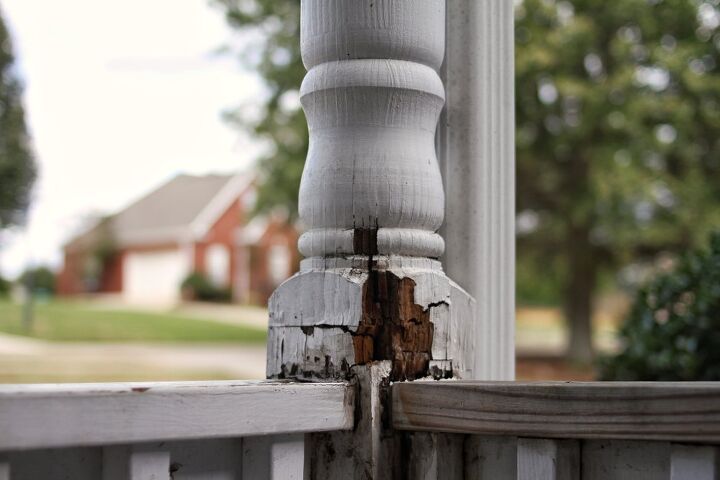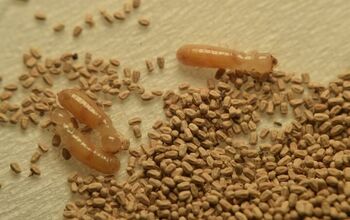Wood Rot Vs. Termite Damage: How to Tell The Difference

Finding damage to the wood in your home can be very scary, especially if you don’t know the cause. It makes sense to compare wood rot vs. termite damage as many often confuse the two. It’s important to know how to identify these issues, and with a closer look, you can spot the differences.
When comparing wood rot vs. termite damage, a closer inspection will typically help you identify the problem. Wood rot is typically either soft and spongy or dry and fragile, often breaking into cube-like pieces when you disturb it. Termite damage generally appears normal on the outside, but the inside will be eaten away with tunnels.
Both wood rot and termite damage can cause significant damage, not to mention the astronomical costs to repair. However, if you catch them early, you can remedy these issues without breaking the bank. This is why inspecting your home annually is so vitally important.
Do You Need Pest Control Services?
Get free, zero-commitment quotes from pro contractors near you.

An Introduction To Wood Rot And Termite Damage
Misidentifying wood rot for termite damage is one of the most common mistakes that homeowners make. After all, they can look an awful lot like each other. Here are some ways to differentiate between these two household issues.
Wood Rot vs. Termite Damage: Texture
Texture is one of the first stops on the identification train. Wood rot has two different looks; soft and spongy or dry and fragile. This damage will be visible on the outside of the wood, as well as the interior.
For termite damage, there are two main identifying features. Damage can look wavy and some areas can appear to be hollowed out. It’s also common for the exterior of the wood to appear intact because of the way that termites tunnel. Termites also create “mud tubes” on the exterior of wood, which can help identify a potential infestation.
Winner: Wood Rot. Since termite damage is not always external, wood rot can be easier to identify.
Wood Rot vs. Termite Damage: Cost To Repair
Wood rot damage costs completely depend on the location and size of the area that needs to be replaced. While some jobs are cheap, damage to a major feature — like a floor joist — can cost up to $12,000. This is why wood rot is so dangerous and should be dealt with immediately.
Termite damage also largely depends on the size of the infestation, damage, and how you decide to treat it. With termites, you must include the cost of extermination along with the cost to repair the damage. With termite tenting on average costing $2,500, repairing termite damage can become expensive very quickly.
Winner: Wood Rot. Wood rot is the winner in this category because the cost of repairs doesn’t include extermination.
Wood Rot vs. Termite Damage: Color
Wood rot in the home is generally either brown or white rot. Brown rot is dry, and as the cellulose shrinks, the color darkens, hence the name “brown rot.” White rot is damp and spongy and leaves the wood with a white/yellowish color.
Termite damage should appear to be the same color as the wood they are eating. There can be darker colors with termite damage due to high moisture, but the color difference is generally minute.
Winner: Wood Rot. Since brown and white rot have such distinct looks, wood rot is easier to identify, making it the winner.
Wood Rot vs. Termite Damage: Smell
One common way to identify wood rot is by the iconic musty smell that comes from fungi growth. Between heavy moisture, warmth, and oxygen, the fungi can mature, leading to wood rot. This damp rot is what produces the earthy, musty smell that accompanies wood rot.
Termites, on the other hand, generally do not have a smell associated with their presence. Termites also love moisture-heavy areas, so there can be a musty smell near their nest.
Winner: Wood Rot. Wood rot is the winner in this category due to its iconic musty smell that leads to easier identification.
Wood Rot vs. Termite Damage: Speed Of Spread
Dry rot is far more dangerous than wet rot, spreading up to 80 mm per day in optimal conditions. If you find evidence of dry rot in your home, you should deal with it immediately to avoid further damage.
Termites are also known to be swift workers. However, the damage is highly dependent on the size of the colony. A well-established colony — around 3 million — can consume one foot of a 2×4 board in a mere 48 hours. A queen termite can lay up to 30,000 eggs a day, which causes termites numbers to increase rapidly.
Winner: Termites. The rate at which termites reproduce poses a greater risk in the speed of damage that your home can face. The increased danger of termites crowns them the winner in this category.
Wood Rot vs. Termite Damage: Breaking Off
One interesting aspect of wood rot is the unique way that the wood breaks into pieces. With wood rot, you’ll typically find that it breaks off into rigid, block-like chunks.
Termite damage, on the other hand, tends to turn brittle and splinter into sharp bits.
Winner: Tie. Both termite damage and wood rot have damage that breaks off in specific ways. While they can appear similar on occasion, they both generally have specific patterns, making this category a tie.
Wood Rot vs. Termite Damage: Location
The most common places to find wood rot are windows and doors, roofs, decks, and basements or high moisture areas. This is due to the high concentration of moisture that you will find in these areas. Much of this damage is from improper installation or leaking damage that has gone untouched for years.
Termites are subterranean, meaning that they live in the ground. You’ll typically find termite damage close to the ground in areas like crawlspaces, basements, and house siding. They are also commonly found in other areas like subflooring and window frames.
Winner: Tie. There is no winner with this category since both wood rot and termite damage target multiple facets of the home.
Wood Rot vs. Termite Damage: Environmental Factors
Certain environmental factors make wood rot thrive. The main factor for wood rot is high moisture content, both for dry and wet rot, as well as warmer temperatures. The ideal temperature for brown and white wood rot is between 65-90 degrees Fahrenheit.
Termites require moisture to keep their bodies hydrated, and if they dry out, they will die. Drywood termites are a species known to reside in dry conditions, but this isn’t the most common type. Termites also enjoy warmer temperatures, between 75 to 90 degrees Fahrenheit, which is why they are most active in the warmer months.
Winner: Tie. Since both wood rot and termites generally require moisture to degrade, this category is a tie.
Related Questions
What is the average cost to fix termite damage?
If you find termites before they have reached full maturity, the cost of extermination and repairs will likely be lower. Unfortunately, the majority of termite infestations fly under the radar until the damage is extensive and requires a significant renovation. The average cost to replace termite damage is $3,000 in addition to the cost of extermination. The cost of extermination varies depending on the type that you get. The most popular treatment techniques are full termite tenting fumigation or spot treatment. Termite spot treatment is far less expensive but is generally only used for small, concentrated infestations. A full tenting termite treatment is more costly — averaging around $2,500 — and is for larger, dispersed infestations.
Can you repair a section of wood rot, or do you have to replace the whole thing?
When it comes to wood, there is potential only to replace the section of the wood that has experienced rot. This is great news, especially if a major structure — like a floor joist or support beam — has evidence of rot.If you can completely split the wood in question, or it crumbles all the way through, you should replace it. If the rot is only in small sections and doesn’t affect the integrity of the wood, you can replace it.To repair wood rot, you must remove all rot entirely and clean the area thoroughly to avoid additional fungi growth. People commonly use wood-patch and polyester filling to patch damaged areas of wood.
Does wood rot mean you have mold?
Wood rot does not mean that you have mold in your home. Fungi is the main ingredient for both wood rot and mold. However, this doesn’t mean they are the same thing. Many believe that wood rots because of moisture, but that is not the case. Wood rots because of fungi growth that thrives in moisture. Mold is also a type of fungi and grows in moisture-heavy areas — bathrooms, basements, etc. Mold commonly accompanies wood rot, so it’s wise to check for mold if you find wood rot and vice versa.
Do You Need Pest Control Services?
Get free, zero-commitment quotes from pro contractors near you.

Final Thoughts
Wood rot and termites cause unbelievable amounts of damage to homes every year. Each one has its own specific dangers, and each grows and thrives in different ways. The amount of damage from either of these culprits highly depends on the size and environment of the infestation.
When it comes to identifying factors, wood rot tends to have more identifying features. The color, smell, and texture of dry and wet rot are very specific and can be easier to pinpoint.
As far as cost and danger of spread are concerned, termites are the clear winner. With the rate of reproduction and the high cost of extermination and damage repair, termites pose a higher risk.

Stacy Randall is a wife, mother, and freelance writer from NOLA that has always had a love for DIY projects, home organization, and making spaces beautiful. Together with her husband, she has been spending the last several years lovingly renovating her grandparent's former home, making it their own and learning a lot about life along the way.
More by Stacy Randall













![10 Best Electric Lawn Mowers - [2022 Reviews & Top Rated Models]](https://cdn-fastly.upgradedhome.com/media/2023/07/31/9070486/10-best-electric-lawn-mowers-2022-reviews-top-rated-models.jpg?size=350x220)













